RESEARCH ARTICLE
Lithium Aluminosilicate Residue as Raw Material in the Production of Sustainable Concrete Masonry Units: A Brazilian Case
Paulo H. R. Borges*, Flávio A. Santos, Nina Milikic, Francisco J. Belieny Jr., Christiano A. Barsante
Article Information
Identifiers and Pagination:
Year: 2016Volume: 10
Issue: Suppl 3: M5
First Page: 418
Last Page: 430
Publisher ID: TOBCTJ-10-418
DOI: 10.2174/1874836801610010418
Article History:
Received Date: 30/4/2015Revision Received Date: 20/5/2015
Acceptance Date: 5/11/2015
Electronic publication date: 28/06/2016
Collection year: 2016

open-access license: This is an open access article licensed under the terms of the Creative Commons Attribution-Non-Commercial 4.0 International Public License (CC BY-NC 4.0) (https://creativecommons.org/licenses/by-nc/4.0/legalcode), which permits unrestricted, non-commercial use, distribution and reproduction in any medium, provided the work is properly cited.
Abstract
Spodumene (LiAlSi2O6) is a natural occurring mineral which is processed to produce lithium carbonate (LiCO3) and lithium hydroxide (LiOH), both used for several industrial and medical applications. The processing of spodumede generates a lithium aluminosilicate residue with no commercial value in Brazil, which is therefore landfilled. This paper studied the effect of the partial replacement of Portland cement (PC) in the production of sustainable concrete masonry units (CMU) for construction. The residue was thoroughly characterized and its interaction with PC was also assessed. Several mixes of CMU were manufactured and compared with a reference mix (without residue). Results indicated that the lithium aluminosilicate is highly reactive and may replace PC in the concrete formulations.
1. INTRODUCTION
Lithium is used for many industrial applications, e.g. ceramics and glasses, mobile phone, automotive batteries and medicine. Lithium is found in nature in granitic pegmatites or brines. Pegmatites deposits occur worldwide containing about 0.01 to 0.85 million tons of Li; the global resource is 3.9 million tons of Li [1]. Economic concentrations occur in highly fractionated and zoned intrusions, the most notable of which in Australia, Canada, Zimbabwe and Zaire [2]. Brine deposits occur mainly in Chile, Argentina and USA. An ample geological data is available in the literature [1, 3, 4]. The most abundant of lithium minerals is spodumene (LiAlSi2O6), a lithium pyroxene containing up to 3.73% Li (8.03% Li2O). Spodumene undergoes a series of mineral processing to produce commercial LiCO3 and LiOH.
The processing of lithium-containing minerals generally comprises crushing, wet grinding, sizing, gravity concentration and flotation. Tailings are discharged to storage areas, and the decanted water is usually recovered for reuse [5]. Bale and May [2] give a comprehensive review of the processing techniques.
Brazil has a single company that produces LiOH and LiCO3 from mineral processing (mainly spodumede). Companhia Brasileira de Litio (CBL) has an annual production of concentrated spodumene of about 11.000 tons, corresponding to a production of approximately 230 tons of dry LiCO3 and 390 tons of LiOH. Lithium in Brazil is used (i) in the manufacture of polishes and lubricants; (ii) as raw materials for the ceramic industry and (iii) in the metallurgy of aluminum. Brazil employs LiO2 neither in the nuclear (reactor sealer) nor in the electrochemical (manufacture of batteries) industries [6, 7]. Figs. (1, 2) show, respectively, the concentration process and production from concentrate at CBL [6].
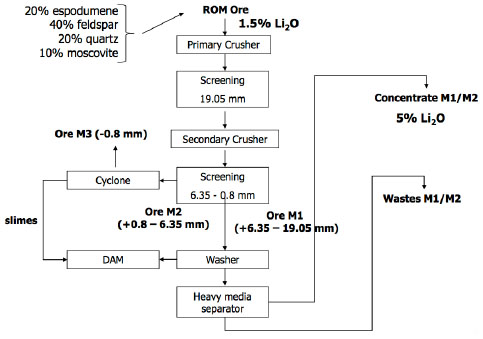 |
Fig. (1). Fluxogram of the concentration of spodumede at CBL [6]. |
Fig. (2) also shows that a hydrous aluminosilicate residue is produced after the leaching step to produce Li2SO4. That residue is the objective of this study. It still contains a small percentage of lithium; therefore, it will be denominated “lithium aluminosilicate residue” (LAR) hereafter. The production of LiCO3 and LiOH in Brazil is low compared to other countries; however, CBL has generated and stocked approximately 120.000 tons of LAR for many years. That amount of residue could be potentially reused in other activities or products to avoid high costs of storage and safe landfilling.
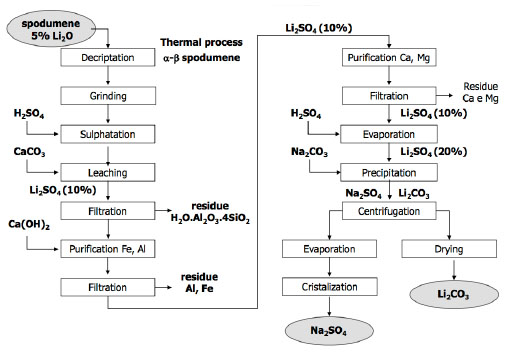 |
Fig. (2). Fluxogram of the production of LiCO3 from concentrate at CBL [6]. |
Aral & Vecchio-Sadus [5] reviewed the risks and toxicity of lithium to humans. They concluded that spodumene is insoluble in water and dilute acids, given that LiO2 is tightly bound to the crystal structure. However, spodumene generates silica-rich dust when it is crushed and processed, which is a well-known health and safety hazard. In addition, other ground minerals are more susceptible to water and dilute acid leaching, especially due to increased surface area. With regard to post-consumer lithium products, it is lithium-based sulfur dioxide-type batteries that pose significant impact to the environment. The residue generated in the CBL plant is classified as Class IIA according to the Brazilian standard NBR 10004 [8], where “II” stands for non-hazardous wastes and “A” for reactive materials. In other words, their constituents are likely to solubilize at higher concentrations than the limit specified in the standard.
1.1. Research Significance
Inappropriate landfilling of residues and wastes may result in contamination of soils and groundwater. Environmental bodies in Brazil, much later than in other developed countries, have started to push industries to safely dispose their residues and wastes, as well as apply severe penalties to those companies that may postpone to tackle this issue. Nowadays the cost of storage or safe landfilling of residues is already high and it will continue to increase for Brazilian companies.
The lithium demand in the future will continue to grow, especially with the potential increasing application in batteries for electric cars. So far there is no evidence in the literature of the employment of LAR from spodumene processing in the production of PC-based materials. It is believed that this residue, as many from other industrial activities, may act as pozzolanic materials or fillers in the production of sustainable construction materials. If viable, the reuse may reduce or prevent the potential environmental impact and enable lithium producers to comply with environmental legislation and avoid penalties. The employment of LAR in the production of concrete masonry units may be also a strategic solution, as:
- The high number of units daily produced in a prefabricated plant enable rapid consumption of the currently landfilled residue;
- Implementation costs are expected to be negligible, possible restricted to complete or incomplete drying of the residue.
- Reduced mechanical strength may be accepted; the ultimate properties will determine whether the units can have structural application (loadbearing concrete masonry unit) or non-loadbearing units for masonry walls.
This paper presents results of a study of a replacement for PC with lithium aluminosilicate residue in the formulations of masonry concrete blocks. The study consisted of three parts: (i) characterization of the residue; (ii) interaction with Portland cement and durability issues; (iii) production and characterization of final products.
2. MATERIALS AND METHODS
2.1. Characterization of The Lithium Aluminosilicate Residue (LAR)
The residue used in this study came from a plant owned and operated by Companhia Brasileira de Lítio (CBL) in the state of Minas Gerais, Brazil. After extraction of lithium from spodumede ore, a powder residue is produced; over the years it has been placed in four piles. Eight samples were collected from random locations in the four LAR existing piles (two from each pile), in order to assess the variability of the stocked material. Those samples (labeled as A1 to A8) were used for characterization.
LAR is not classified (sieved) and the size of the particles ranges from a few millimeters to 0.1 micrometers. Thus, a manual sieve analysis was carried out to determine the percentage above 0.15 mm, retained between 0.15-0.075 mm and below 0.075 mm. The fraction below 0.075 mm (75 μm) has special interest, as it could be reactive and, therefore, present pozzolanic properties. This fraction was then submitted to LASER particle size analysis (Cilas 1064), X-ray diffraction (Shimadzu XRD-7000, 2θ = 5° to 80°, at 1° per minute, step size of 0.02) and the specific gravity calculated using the Le Chatelier flask for cementitious materials.
2.2. Interaction Between The LAR and Rapid-Hardening PC
The objective of this characterization part was to determine the effect of the interaction between the LAR and PC in the fresh properties of cement pastes and mortars. Firstly, the water content required for a normal consistency paste and setting time were determined for mixes containing 0, 10, 20, 30, 50 and 60 % wt. of LAR. An initial mix of 60/40 LAR/ PC mix was also tested for soundness (using the Le-Chatelier soundness test for cement).
Mortars containing PC, LAR and Brazilian standard quartz sand (controlled particle size distribution) were made with the same amounts of residue used for pastes (10-60 % except for 40 %). The water to cement ratio and aggregate to binder ratio were fixed to 0.48 and 3.0, respectively, as required for determination of strength and consistency (flow table test) [9].
The pozzolanic activity index (or strength activity index) was carried out according to the Brazilian standard NBR 5752 [10], which is very similar to ASTM C311 [11]. In the first, 30 % vol. of PC is replaced with the pozzolanic material (in this case, LAR). The water content is not fixed, but rather adjusted so that the reference mix (neat PC) and blended mix (70% PC + 30% pozzolan in vol.) have same consistency measured with the flow table test. The pozzolanic activity index (PAI) is the ratio between the strength of the blended mix and reference mix at 28 days, measured in cylinders of 50 × 100 mm (diameter × height). In this study, PAI was determined at 14 and 28 days of curing.
The pozzolanic reaction was also assessed using thermogravimetric analysis (TGA). Two pastes were made: (i) neat PC and (ii) 20 % wt. replacement of PC. Both pastes were kept in a desiccator in order to prevent carbonation. They were then sent to TGA analysis (10° C / min. from room temperature to 1000°C, under N2 atmosphere) at the desired time, i.e. 7, 14 and 28 days. The amount of calcium hydroxide was then calculated for the two pastes. The reactivity of the LAR was estimated based on the reduction of the Ca(OH)2 content with time and formation of calcium silicates, calcium aluminate and calcium sulphoaluminate hydrates.
Alkali-silica reaction (ASR) is a typical long-term expansive attack to PC-based materials when the aggregate is reactive and the amount to alkalis in the system is reasonably high, i.e. above 0.6% of Na2O eq. [12-14]. The presence of LiO2 is not an issue for the development of alkali-silica reaction; this oxide is rather a suppressor of that chemical attack, as the lithium-silica-gel formed does not absorb water and, therefore, does not swell [12, 15, 16]. However, mortars were tested for soundness, as the LAR also contains significant amounts of Na2O and K2O. ASTM 1260 [17] was used as accelerated test; 25 × 25 × 285 mm prisms were cast, cured and kept submerged into a 1 N NaOH solution at 80°C for 28 days. The high concentration of the solution and the high temperature accelerate any possible ASR and expansion of the prisms, which is monitored by comparing the length change of the samples. The ASR is more likely to take place when reactive particles are coarser [18]. Therefore, it was decided to test the susceptibility of both LAR and coarser particles of spodumene aggregates to ASR. Three different mixes were made for soundness: (i) the first mix contained 100% PC (no LAR) and fine aggregate (0.15 to 6.3 mm) obtained from the mining of spodumene; (ii) the second mix contained 50% of PC and 50% of LAR as binder. Innocuous quartz sand was the aggregate for this particular mix; (iii) the third mix was a combination of (i) and (ii), i.e. 50% PC, 50% LAR and the aggregate from the mining of spodumene. Those three mixes could determine whether ASR was likely to be formed and the effect of fine and coarser particles on the expansion.
A rapid-hardening PC (Brazilian type V) was supplied by Holcim Brazil and used in all tests listed in 2.2. This type of cement was used because it contains minor mineral additions in composition (up to 5% limestone filler).
2.3. Production and Characterization of Concrete Masonry Units (CMU)
CMU were produced at a local industry in the city of Belo Horizonte, Brazil, using a fully automatic machine. Table 1 shows the mix formulations. Five different formulations were made: a reference formulation contained no LAR and it was exactly the mix design used by the local manufacturer. Other formulations contained 20%, 30%, 40% and 50% of LAR replacing PC. The aggregate to binder ratio was equal to 20 for all mixes; the water to binder (w:b) ratio was 0.78 for all mixes, except for Mix E (containing 50% LAR), which required more mixing water during the production (w:b = 0.88). It is important to note that the LAR was neither sieved nor screened for the production tests. The idea was to use the residue as it is, not to increase the production costs. In that case, the fine particles (below 75 μm) may act as a pozzolanic material and the coarse particles as fine sand.
Mix formulations (in kg) for the CMU studied.
| Raw Materials | Mix A (Reference) |
Mix B (20% LAR) |
Mix C (30% LAR) |
Mix D (40% LAR) |
Mix E (50% LAR) |
|---|---|---|---|---|---|
| Stone dust | 350 | 350 | 350 | 350 | 350 |
| Fine gravel | 150 | 150 | 150 | 150 | 150 |
| Lithum Aluminium Silicate (LAR) | 0 | 5 | 7.5 | 10 | 12.5 |
| Rapid-hardening PC | 25 | 20 | 17.5 | 15 | 12.5 |
| Water | 18 | 18 | 18 | 18 | 22 |
| Plasticizer | 0.35 | 0.35 | 0.35 | 0.35 | 0.35 |
| TOTAL | 543.35 | 543.35 | 543.35 | 543.35 | 547.35 |
| Number of CMU produced | 54 | 54 | 54 | 54 | 54 |
| kg of LAR / CMU | 0 | 0.093 | 0.139 | 0.185 | 0.231 |
Twenty units of each formulation were tested in compression and the mean compressive strength and standard deviation calculated. The water absorption was measured using another 6 units of each formulation; the results were also expressed in terms of mean and standard deviation.
Two units of each formulation were cut with an electric saw (Fig. 3) and the small prims (approximately 100 mm × 50 mm × 30 mm) were submitted to the “tank test” leaching, described by the Environment Agency standard EN NEN 7375:2004 [19]. In this dynamic leaching test, the leachate is collected from 0.25 h to 64 days (8 extractions) and the cumulative leaching is plotted against the time of testing. ICP-MS was used to determine the leaching of Li, Na and K from CMU containing 20-50% of LAR.
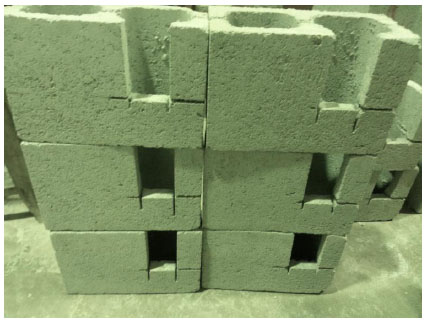 |
Fig. (3). CMU after extraction of samples for leaching. |
3. RESULTS AND DISCUSSION
3.1. Characterization of LAR
Table 2 gives the chemical composition of the LAR as provided by the manufacturer, CBL. It is possible to see that the percentage of SiO2 is predominant, as well as the Al2O3, which is typical for aluminosilicates used in the production of cement and concrete [20]. It is also noticeable that the amount of alkalis, i.e. LiO2, Na2O and K2O, are relatively high. Although lithium is known to mitigate the alkali silica reaction (ASR), the high amounts of Na and K oxides could represent a risk of ASR. However, the Na2O and K2O content (0.445 and 4.525%, respectively) are at the same level as those found in fly ash used for OPC and concrete production in countries such as France or Germany [21]. The susceptibility to ASR will be addressed in section 3.2.5.
Chemical composition of LAR (%).
| SiO2 | Al2O3 | CaO | LiO2 | Na2O | K2O | P2O5 | Fe2O3 | CoO | Mn2O3 | Cr2O3 | MgO | |
| LAR | 69.17 | 20.025 | 2.239 | 0.959 | 0.445 | 4.525 | 0.423 | 0.450 | traces | 0.064 | traces | 0.022 |
X-ray diffraction (XRD) of the 8 samples (A1 to A8) collected from the LAR stocking piles was also carried out, in order to assess the phases present and the variability of the stocked residue. Fig. (4) shows only one XRD diffractogram, given that the eight XRD traces were nearly identical. This indicates that the LAR samples were homogeneous in terms of mineralogical composition. XRD analysis yielded a diffraction plot with distinctive peaks, implying the presence of crystalline phase solids in the LAR. The most abundant phase is an aluminosilicate of molecular formula of C0.24Al3.56Cl0.76Na2.76O28Si8.44, which occurs in nature as the silicate mineral marialite (M) [22]. Other phases in minor quantities are spodumene (S), quartz (Q) and bassanite (B).
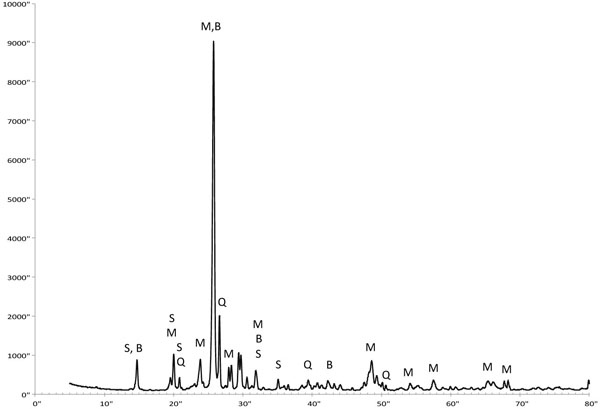 |
Fig. (4). XRD difractogram of LAR (PSD < 75 µm). S = spodumene; M = marialite, Q = quartz, B = bassanite. |
Manual sieving has determined the fraction of the LAR retained in a 0.15 mm sieve, between 0.075 - 0.15 mm and passing 0.075 mm. The vast majority of LAR (75.3%) has particle size below 75 microns, which is desirable to replace the PC in concrete formulations. Yet 17.5% of the material has particle size between 0.075 - 0.15 mm and 7.2% are coarser than 0.15mm; both fractions may act as a fine aggregate rather than a reactive material. Five samples of LAR with particle size below 75 μm were submitted to Laser PSD. The equipment does not detect coarser particles of LAR (in the range of mm). Fig. (5) shows the particle size distribution and cumulative distribution for one sample, as the others have nearly identical PSD curve. Overall, the mean particle size ranged from 11.91 to 13.58 μm. Results also have shown that 100% of the particles submitted to Laser PSD (i.e. diameter < 75 μm) have particle size below 30 μm. This fine fraction of LAR may demand more mixing water to maintain the same workability.
 |
Fig. (5). Particle size distribution of LAR (PSD < 75 µm). |
With regard to particle density, two samples of LAR had same results, equal to 2,50 g/cm3. This fine fraction of LAR is then less dense than PC (~ 3,14 g/cm3) [23]. This should be taken into account when preparing concrete mixtures, as the proportions of components are usually measured in volume. On the other hand, if PC is replaced with LAR in wt. percentage, attention should be paid to the fact that the volume of LAR will be greater than the replaced (PC), what may also demand more mixing water.
3.2. Interaction of LAR with PC
3.2.1. Setting Time and Soundness
Table 3 shows results of water for consistency, as well as initial and final setting time for pastes containing various amounts of LAR (particles < 75 μm). It is possible to observe that both the water demand to ensure equal consistency and setting times rose with increasing LAR in the pastes. Ribeiro et al. [24] found similar behavior when studied the partial replacement (up to 30%) of PC with red mud from the aluminum production. The replacement of cement with finer materials demand more water to maintain a normal consistency; the increased amount of water delay the formation of initial hydrates that are responsible for stiffening and subsequent setting of the paste. The setting results indicate that concrete products made with LAR may require prolonged curing before demoulding. The 60/40 LAR/PC paste did not present any expansion (below 1 mm) when the Le Chatelier soundness test was carried out; therefore, expansion may not be an issue due to the presence of minor non-identified phases or even calcium sulfate (bassanite) present in the LAR.
Water for consistency, initial and final setting time for mixes with LAR.
| % LAR | % H2O* | Initial Set | Final Set |
|---|---|---|---|
| 0 | 33.0 | 3h 00 min | 3h 50 min |
| 10 | 34.0 | 3h 00 min | 3h 00 min |
| 20 | 34.5 | 3h 25 min | 4h 20 min |
| 30 | 36.0 | 3h 55 min | 5h 05 min |
| 50 | 39.5 | 4h 55 min | 6h 05 min |
| 60 | 41.2 | 5h 00 min | > 6 h |
3.2.2. Consistency Index of Mortars
The effect of the LAR addition in the fresh properties of construction materials is evident with the results of the consistency index for mortars. This test measures the diameter of the mortar after it has been spread by the operation of the flow table (30 strokes). Table 4 shows that the replacement by weight of cement with LAR decreases the consistency of the concrete mixture. It can be observed that the reference mortar (without silicate) has a consistency index of 175 mm, which is reduced to 100 mm when 60% of LAR replaces PC. The reduction in the consistency index may be a problem in developing conventional concretes and mortars, which will demand more mixing water or at least more admixtures. However, this should not be an issue when drier mixtures are used, such as the production of pre-fabricated elements.
Consistency index for mortars containing LAR.
| LAR content [%] | 0 | 10 | 20 | 30 | 50 | 60 |
|---|---|---|---|---|---|---|
| Consistency index [mm] | 175 | 155 | 140 | 135 | 115 | 100 |
3.2.3. Compressive Strength of Mortars and Pozzolanic Activity Index (PAI)
Compressive strength or mortars was carried out to give an indirect assessment of the pozzolanic activity of LAR. Fig. (6) shows the curves for 7, 14 and 28 days compressive strength for mortars containing up to 60% LAR (% wt). Each point on the graph is the average of 4 specimens, and the error bars correspond to the standard deviation. It can be observed that the compressive strength increased with age for all mortars, which is more prominent for those with 10-30% LAR. In fact, the increase of strength for the reference formulation (0% LAR) was not expected, as the rapid-hardening PC achieves most of its strength between 7-14 days. On the other hand, mortars with 50-60% LAR may not contain sufficient amount of PC (and, consequently, portlandite) to promote pozzolanic reaction. Overall, Fig. (6) shows that the compressive strength of mortars did not change much at 14 and 28 days for a replacement of 30% wt. PC or less. Further additions of LAR may reduce the strength of mortars or concretes even at prolonged age.
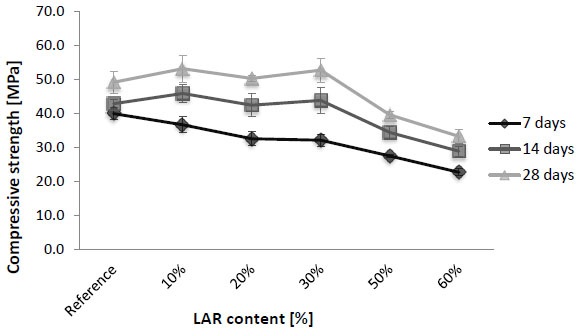 |
Fig. (6). Development of compressive strength in mortars (w / binder = 0.48 and aggregate / binder = 3.0) containing from 0% to 60% LAR (PSD < 75 µm) |
Fig. (7) shows the results of the pozzolanic activity index. A material is considered to be reactive or pozzolanic according to the Brazilian standard NBR12653: 2012 [25] when the pozzolanic activity index (PAI) is greater than 0.75 or 75%. In this case, the PAI was 0.89 at 14 days and 1.02 at 28 days. PAI results for LAR are comparable with those found by Donatelo et al. [26] for metakaolin, and higher than those for fly ash and silica fume. In other words, LAR is considered pozzolanic even at 14 days, with high pozzolanic activity at 28 days.
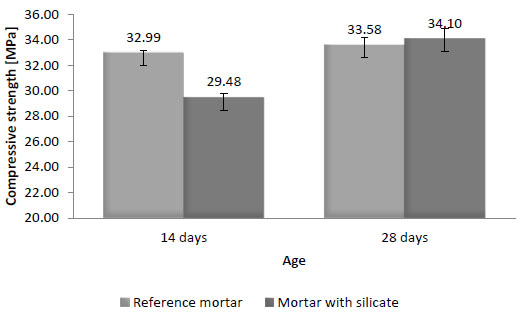 |
Fig. (7). Compressive strength of reference mortar and mortar with 30% vol. LAR, for calculation of Pozzolanic Activity Index. |
3.2.4. Thermogravimetry Analysis (TGA)
Fig. (8) shows the Ca(OH)2 content at 7, 14 and 28 days in the reference and composite pastes studied. The calcium hydroxide content was calculated using the TGA and DTG curves for the decomposition region of this compound (420-550°C) and also using the decarbonation region of CaCO3 (between 600-800°C), as it was assumed that all carbonates in the samples were originated from carbonation of Ca(OH)2 during the preparation of samples [27]. Fig. (8) also shows the weight loss in the region between 100-420°C at ages 7, 14 and 28 days, which may be used to estimate the combined water in the calcium silicate, calcium aluminate and calcium sulphoaluminate hydrates present in the pastes [28]. Therefore, an increase in the weight loss in that region corresponds to an increased formation of hydrates due to the pozzolanic reaction.
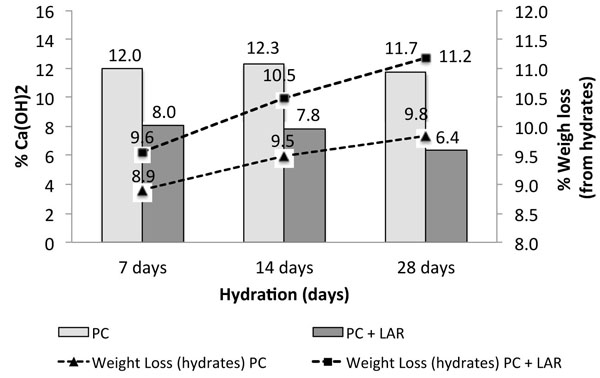 |
Fig. (8). Evolution of Ca(OH)2 content and estimated weight loss from calcium silicate hydrate, calcium aluminates and ettringite in the reference paste (PC) and paste containing PC+LAR. |
It is possible to see that the reference paste has developed most of the hydration reactions between 7 and 14 days, as a consequence of the use of a rapid-hardening cement. This data for PC agrees with the findings of Vedalakshmi et al. [29], who found exactly 12% of Ca(OH)2 for a fully hydrated PC paste. However, there is still an increase of the amount of hydrates between 7 and 14 days, characterized by increasing weight loss in the region of 100-420°C (8.9 – 9.8%).
There is a gradual reduction of the Ca(OH)2 content from 7 to 28 days for the paste containing LAR, which indicates pozzolanic reaction. This is supported with increasing weight loss at 180-300°C (2.35 - 2.70%), showing the formation of hydrates in parallel with the consumption of calcium hydroxide. Remarkably, the weight loss between 180-300°C is practically the same for the two pastes at 28 days (2.70 and 2.72). Therefore, the TGA analysis is in line with the PAI results, confirming that LAR is a pozzolanic material.
3.2.5. Accelerated Alkali-Silica Reaction
Fig. (9) shows the linear expansion of prims made with PC and LAR, in combination with natural (quartz) aggregate and spodumede aggregate. Three samples of each formulation were tested and the results of expansion are expressed in terms of the mean. The standard variation was calculated but not plotted in Fig. (9) to maintain neatness. The highest standard variation was 0.005% in all cases. The three formulations studied did not present any significant expansion up to 28 days of accelerated testing. On the contrary, all formulations presented a slight shrinkage at 28 days. Those results confirm that the employment of LAR and even spodumene aggregates do not represent a risk for ASR, as a limit of 0.1% linear expansion at 28 days is still accepted so that prims are not susceptible to ASR.
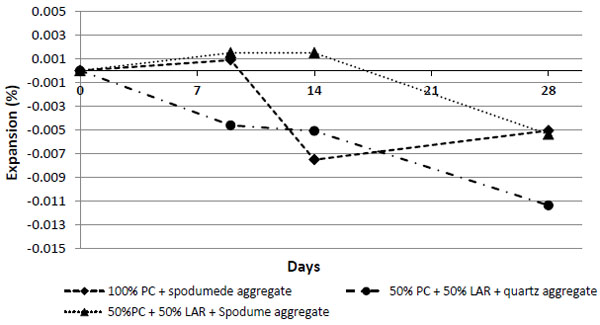 |
Fig. (9). Accelerated ASR: Linear expansion of prisms according to ASTM C1260. |
3.3. Characterization of Concrete Masonry Units (CMU) Containing LAR
The characterization of CMU comprised (i) compressive strength; (ii) water absorption; leaching of alkalis (Li, K and Na). The Brazilian standard NBR 6136 “Hollow concrete blocks for structural masonry” was used as reference. This standard defines that CMU for structural masonry must have a minimum compressive strength of 4.5 MPa (lowest concrete class). In addition, the water absorption must be below 10% for each individual CMU tested, carried out using the water saturation method.
Fig. (10) shows the compressive strength of the MCU produced, as a function of the LAR content. It is possible to observe that the mean strength slightly decreased for 30% LAR content onwards. However, in general, all CMU’s may be classified as structural masonry units, as they all have mean compressive strength above 4.5 MPa and water absorption much lower than 10% (Table 5). One may indirectly assess the pozzolanic behavior of LAR by looking at the difference in strength between 14 and 28 days. In that case, mixes with 40% and 50% do not show any significant increase in strength from 14 to 28 days, which indicates that there was not sufficient PC in those mixes to promote the pozzolanic reaction.
Water absorption of CMU.
| LAR content in [%] | 0 | 20 | 30 | 40 | 50 |
|---|---|---|---|---|---|
| Water absorption [%] | 6.12 | 5.85 | 5.83 | 6.37 | 5.95 |
| Standard deviation [%] | 0.38 | 0.32 | 0.78 | 0.17 | 0.75 |
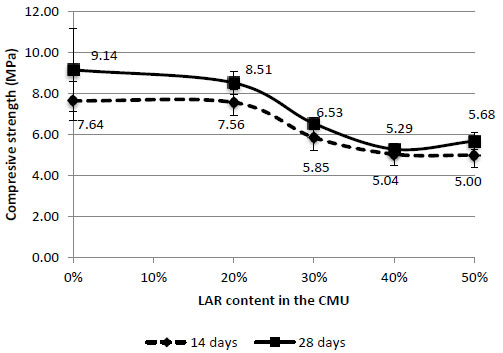 |
Fig. (10). Compressive strength of CMU produced with LAR. |
The MCU’s must also comply with some local legislation with regard to the leaching of alkalis. Table 6 shows the limits for Na, and Li. There is no limit for K in Brazil, but leaching of potassium was also carried out and for calculation of the concentration of Na equivalent.
Concentration limits of alkalis in leachates.
| Element | Concentration limits | Reference |
|---|---|---|
| Na | < 200 mg/l | Standard NBR 1004:2004 (ABNT, 2004); |
| Li | < 2.5 mg/l | Legislation COPAM/CERHMG:2008 [23] |
Figs. (11-13) show the cumulative leaching of Na, K and Li, respectively, from the MCU produced. The cumulative concentration of Na is well below the concentration limit permitted (200 mg/l), which indicates that the leaching of this element does not represent a risk if contamination of soil and underground water. Even if the cumulative concentration of K (Fig 12) is transformed into sodium equivalent (i.e., Naeq = Na + 0.658 × K) and added to the cumulative concentration of Na in Fig. (11), the cumulative leaching of Na would be below 200 mg/l. The cumulative leaching to Li is below 2.5 mg/l in all cases. However, the cumulative leaching of this element is generally higher for MCU’s with higher LAR content. On the contrary, the leaching of Na and K appear to be higher when the PC content is higher in the mixes, which can be observed for CMU with 20% LAR (80% PC).
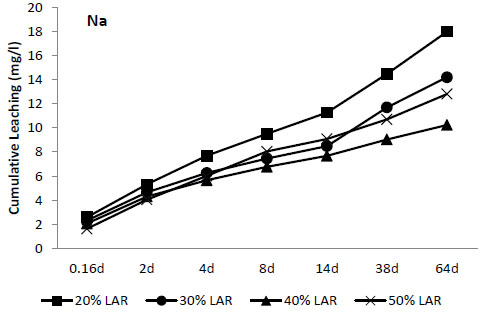 |
Fig. (11). Leaching of Na from CMU containing LAR. |
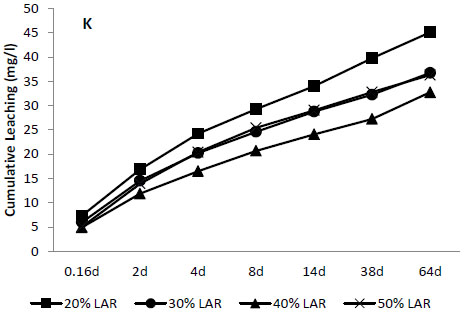 |
Fig. (12). Leaching of K from CMU containing LAR. |
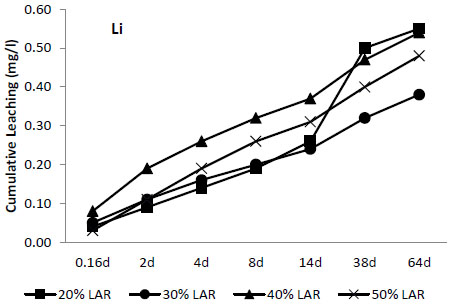 |
Fig. (13). Leaching of Li from CMU containing LAR. |
CONCLUSION
This paper investigated the replacement of Portland cement (PC) with a lithium aluminosilicate residue (LAR) from the spodumede mining and processing, as raw material in the production of concrete masonry units (CMU). The conclusions of this work are:
- The samples from LAR residue collected from existing piles at Companhia Brasileira de Lítio (CBL) have similar mineralogical composition, as well as particle size distribution. When LAR mixed with PC, the pastes did not show any issues with regard to reduced setting time and soundness, when up to 60% of LAR replaces Portland cement. However, the fine portion of LAR is finer than PC; therefore, a high level of replacement demands more mixing water for the same consistency.
- LAR may replace PC in concrete formulations, as it is a high pozzolanic material. This was evident for mortars made with w/b ratio of 0.48 and aggregate / binder ratio of 3.0; the addition of up to 30% wt. LAR has similar compressive strength to reference mortars (no LAR addition). Termogravimetric analysis and pozzolanic activity index (PAI) proved that LAR is highly pozzolanic.
- Accelerated alkali-silica reaction testing (ASTM C1269) has shown that the presence of alkalis in the composition of LAR does not represent any risk of expansion, either using fine residues (LAR, particle size below 75 μm) or other alkali-rich aggregates used in the mining of spodumede. The presence of lithium may suppress and possible reaction and consequent expansion.
- Structural masonry concrete units (MCU) may be produced with up to 50% replacement of PC with LAR. All MCU produced comply with Brazilian standards with regard to minimum compressive strength and maximum water absorption for structural applications. The leaching of alkalis (Na, K and Li) from those MCU is well below the limits recommended by Brazilian legislations; therefore, LAR may be used with any risk of soil and groundwater contamination.
CONFLICT OF INTEREST
The authors confirm that this article content has no conflict of interest.
ACKNOWLEDGEMENTS
The authors would like to thank Companhia Brasileira de Lítio (CBL) for funding this research, carried out at the Federal Centre for Technological Education of Minas Gerais (CEFET-MG), Brazil.
REFERENCES
| [1] | S.E. Kesler, P.W. Gruber, P. Medina, G. Keoleian, M.P. Everson, and T.J. Wallington, "Global lithium resources: relative importance of pegmatite, brine and other deposits", Ore Geol. Rev., vol. 48, pp. 55-69, 2012. |
| [2] | M.D. Bale, and A.V. May, "Processing of ores to produce tantalum and lithium", Miner. Eng., vol. 2, no. 3, pp. 299-320, 1989. |
| [3] | D.E. Garrett, Handbook of Lithium and Natural Calcium Chloride: Their Deposits, Processing, Uses and Properties., 1st ed Academic Press: USA, 1994. |
| [4] | H. Vikström, S. Davidsson, and M. Höok, "Lithium availability and future production outlooks", Appl. Energy, vol. 110, pp. 252-266, 2013. |
| [5] | H. Aral, and A. Vecchio-Sadus, "Toxicity of lithium to humans and the environment-a literature review", Ecotoxicol. Environ. Saf., vol. 70, no. 3, pp. 349-356, 2008. |
| [6] | S.C. França, and P.F. Braga, "Challenges and tecnologies for production of lithium carbonate from ores to attend the EV market", In: Business Meeting with Japanese Companies interested in the Lithium Production Chain. Brazil, 2011, p. 17. |
| [7] | J.C. Pinheiro, "Ores for the production of a brazilian lithium ion battery", In: Business Meeting with Japanese Companies interested in the Lithium Production Chain. Brazil, 2011, p. 49. |
| [8] | "Solid Waste - Classification". NBR 10004, Associação Brasileira de Normas Técnicas (ABNT): Brazil, 2004. pp. 1- 71. Available at: http://www.videverde.com.br/docs/NBR-n-10004-2004.pdf |
| [9] | "Portland Cement - Determination of Compressive Strength". NBR 7215, Associação Brasileira de Normas Técnicas (ABNT): Brazil, 2007. pp 1-8. Available at: http://www.slideshare.net/sheyqueiroz/nbr-721596-cimento-portland-resistncia-a-compresso |
| [10] | "Pozzolans - Determination of Pozzolanic Activity with Portland Cement - Test Method". NBR 5752, Associação Brasileira de Normas Técnicas (ABNT): Brazil, 2012. pp 1-4. Available at: https://www.abntcatalogo.com.br/norma.aspx?ID=315344 |
| [11] | "Standard Test Methods for Sampling and Testing Fly Ash or Natural Pozzolans for Use in Portland-Cement Concrete". C311-C311M, ASTM International (ASTM): Brazil, 2013. pp. 1-10. Available at: http://www.astm.org/Standards/C311.htm |
| [12] | X. Feng, M.D. Thomas, T.W. Bremner, R.J. Balcom, and K.J. Folliard, "Studies on lithium salts to mitigate asr-induced expansion in new concrete: a critical review", Cement Concr. Res., vol. 35, pp. 1789-1796, 2005. |
| [13] | S. Chatterji, "Chemistry of alkali-silica reaction and testing of aggregates", Cement Concr. Compos., vol. 27, pp. 788-795, 2005. |
| [14] | "Report on Alkali-Aggregate Reactivit". ACI 221.1 R-98, American Concrete Institute (ACI): Brazil, 2008. pp. 1-30. Available at: https://www.concrete.org/store/productdetail.aspx?ItemID=221198&Format=DOWNLOAD |
| [15] | D. A. Micheal, F. Benoit, J. Kevin, H. Jason, and Y. Resendez, "The Use of Lithium to Prevent or Mitigate Alkali-Silica Reaction in Concrete Pavements and Structures". The Transtec Group Inc, US Department of Transportation (USDT): Brazil, 2007. Available at: https://www.google.com.pk/search?q=NBR+10004&hl=en&#hl=en&q=he+Transtec+Group+I |
| [16] | M. Thomas, "The effect of supplementary cementing materials on alkali-silica reaction – A review", Cement Concr. Res., vol. 41, pp. 1224-1231, 2011. |
| [17] | ASTM International (ASTM) C1260, Standard Test Method for Potential Alkali Reactivity of Aggregates. ASTM: Mortar-Bar Method, 2007, p. 5. |
| [18] | S. Multon, M. Cyr, A. Sellier, N. Leklou, and L. Petit, "Coupled effects of aggregate size and alkali content on ASR expansion", Cement Concr. Res., vol. 38, pp. 350-359, 2008. |
| [19] | "Leaching Characteristics - Determination of the Leaching of Inorganic Components from Moulded or Monolithic Materials with a Diffusion Test - Solid Earthy And Stony Materials." NEN 7375, Netherlands Normalisatic Institute: Netherland, 2005. pp. 1-32. |
| [20] | ACI Committee E-701, Cementitious Materials for Concrete, American Concrete Institute (ACI): Brazil, 2001, pp. 1-32. Available at: https://www.concrete.org/portals/0/files/pdf/e3-13.01.pdf |
| [21] | F. Massazza, "Pozzola and Pozzolanic Cements", In: P. Hawlett, Ed., Lea's Chemistry of Cement and Concrete, 4th ed. Elsevier Ltd.: UK, 2004, p. 484. |
| [22] | W.A. Deer, R.A. Howie, and J. Zussman, Rock-Forming Minerals: Framework Silicates-Silica Mineral, Feldspathoids and Zeolites, 2nd ed. The Geographical Society: London, 2004, vol. 4b, p. 982. |
| [23] | P.K. Mehta, and P.J. Monteiro, Concrete: Microstructure, Properties and Materials, 3rd ed. McGraw Hill: US, 2006, p. 659. |
| [24] | D.V. Ribeiro, J.A. Labrincha, and M.R. Morelli, "Potential use of red mud as pozzolan for Portlan cement", Mater. Res., vol. 14, pp. 60-66, 2011. |
| [25] | "Pozzolans - Requirements". NBR 12653, Associação Brasileira de Normas Técnicas (ABNT): Brazil, 2012. pp. 1-5. Available at: http://www.ebah.com.br/content/ABAAAg5tQAJ/nbr-12653-materiais-pozolanicos |
| [26] | S. Donatello, M. Tyrer, and C.R. Cheeseman, "Comparison of test methods to assess pozzolanic activity", Cement Concr. Compos., vol. 32, pp. 121-127, 2010. |
| [27] | P.H. Borges, J.O. Costa, N.B. Milestone, C.J. Lynsdale, and R.E. Streatfield, "Carbonation of CH and C-S-H in composite cement pastes containing high amounts of bfs", Cement Concr. Res., vol. 40, pp. 284-292, 2010. |
| [28] | L. Alarcon-Ruiz, G. Platret, E. Massieu, and A. Ehrlacher, "The use of thermal analysis in assessing the effect of temperature on a cement paste", Cement Concr. Res., vol. 35, pp. 609-613, 2005. |
| [29] | R. Vedalakshmi, A. Sundara Raj, S. Srinivasan, and K. Ganesh Babu, "Quantification of hydrated cement products of blended cements in low and medium strength concrete using TG and DTA technique", Thermochim. Acta, vol. 407, pp. 49-60, 2003. |








